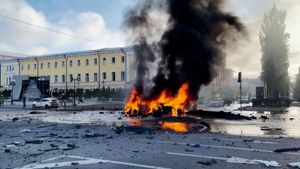China's Chang'e-6 mission has opened up new avenues of exploration for lunar geology, particularly for the previously uncharted far side of the Moon. This mission marks the first time samples have been taken from this mysterious region, historically known for harboring many unknowns due to its unique geological characteristics. The mission returned 1,935 grams of lunar soil back to Earth, providing unprecedented insights.
A recent study, led by Professor Qiuli Li from the Institute of Geology and Geophysics of the Chinese Academy of Sciences, reveals volcanic activity on the lunar far side dating between 4.2 and 2.8 billion years. Published in the esteemed journals Nature and Science, the findings offer a glimpse of the Moon’s tumultuous volcanic past, which remains starkly different from the well-studied near side.
One key highlight from the Chang'e-6 discoveries is the age of the basalt fragments. Researchers found multiple fragments consistently dated around 2.8 billion years, indicating active volcanic processes at the sample site. This is notable because basalts of this age had not been observed previously among near-side samples. The data points to two distinct volcanic periods: one during the early formation of the lunar crust and another significantly more recent.
"Unraveling the volcanic history of the lunar farside is important for comprehending the hemispheric dichotomy of the Moon," stated Prof. Li during the study. This dichotomy refers to the stark differences between the near and far sides, which have shown contrasting geological features such as distribution of basalt, topography variations, and differences in crustal thickness.
The first eruptive phase identified was through high-aluminum basalt, dated 4.2 billion years old, likely originating from the cryptomare region south of the landing site. This finding adds to the lunar geological puzzle and suggests there is more to discover about the Moon's volcanic activity.
On the other hand, the analysis presented some surprises. The absence of radioactive elements known from earlier samples taken during the Apollo missions raises questions about the heat sources responsible for maintaining volcanic activity on the Moon for billions of years. Given the Moon's small size, it was expected to have cooled quickly.
After conducting systematic radioisotope dating on over 100 basalt fragments from the samples, the research teams found one fragment dating back to this surprising volcanic period, showcasing the Moon's complex geological timeline.
"The relatively young ages of these basalts, alongside the lack of previously common volatile elements, prompt speculation on the underlying geology of the Moon," commented Clive Neal, co-author of the corresponding paper published in Science.
Overall, the findings from the Chang'e-6 mission not only shine light on the far side's past but also point toward the need for more extensive exploration to unravel the mysteries beneath the surface. With continued research and collaboration among international teams, scientists aim to learn more about how the Moon evolved and the factors governing its geological activity.
These discoveries could reshape existing lunar models and inform future exploration missions, providing insight not just about the Moon, but potentially about the geological processes of other celestial bodies as well.
The mission is part of China's broader ambition to assert itself as a major player in space exploration, following successful projects like Chang'e-5, which brought back samples from the Moon’s near side just two years ago. With Chang'e-6, China has set its eyes on the unique geological history of the lunar far side, raising new questions and opportunities for groundbreaking discoveries.
To date, the Chang'e-6 mission results have set the stage for future investigations on the Moon's surface and subsurface. Researchers are eager to examine the samples not only to confirm existing theories but to explore new avenues of lunar science.
This latest analysis is only the tip of the iceberg—more studies are anticipated as the lunar scientific community pools resources and knowledge to decode the Moon's secrets. Prof. Li emphasized the importance of this mission for planetary science, underlining its potential to enrich our broader understandings of solar system history and development.



